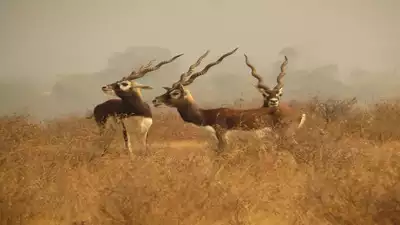In response to the burgeoning population of chital (spotted deer) in Ross Island, the Andaman and Nicobar Islands administration has sought assistance from the Wildlife Institute of India. This step underscores the growing concern over invasive species and their impact on ecosystems.
Background
Chital, originally from mainland India, were introduced to Ross Island by the British in the early 20th century. Lacking natural predators and competitors, these deer swiftly spread throughout the Andaman archipelago.
Definition of Invasive Alien Species (IAS)
The Convention on Biological Diversity (CBD) defines Invasive Alien Species (IAS) as organisms whose introduction or spread outside their natural habitat poses a threat to biological diversity. These species, including animals, plants, fungi, and microorganisms, can significantly impact native ecosystems.
Legal Framework in India
In India, the Wildlife Protection Act of 1972 (amended in 2022) defines IAS as species not native to India whose introduction or spread may harm wildlife or its habitat. This definition does not encompass species that are invasive in specific regions, such as chital in the Andamans.
Examples of Invasive Wildlife in India
Certain fish species like the African catfish, Nile tilapia, red-bellied piranha, and alligator gar, as well as turtle species like the red-eared slider, dominate the list of invasive wildlife in India. These species often disrupt native ecosystems due to their rapid reproduction rates and competitive advantages.
Impact on Ecosystems
Invasive species, by disrupting food chains and ecosystems, can severely affect biodiversity. They often outcompete native species and disturb the natural balance of ecosystems. For instance, the African catfish in Keoladeo National Park has been observed preying on waterfowl and migratory birds.
Economic and Environmental Consequences
The proliferation of invasive species globally has significant economic costs, estimated at over $423 billion annually. In India, examples like the cotton mealy bug, which severely affects cotton crops in the Deccan region, highlight the economic impact of IAS.
Recent Developments
In September 2023, the Intergovernmental Platform on Biodiversity and Ecosystem Services (IPBES) released a comprehensive report on invasive species, revealing the introduction of approximately 37,000 established alien species worldwide, with around 200 new species introduced annually.
Multiple Choice Questions (MCQs) with Answers:
- What organization recently sought help from the Wildlife Institute of India to manage the chital population in Ross Island?
- A) Andaman and Nicobar Islands Wildlife Department
- B) Ross Island Preservation Society
- C) Andaman and Nicobar Islands administration
- D) Andaman and Nicobar Islands Environmental Agency
- Answer: C) Andaman and Nicobar Islands administration
- According to the CBD, what characteristics define Invasive Alien Species (IAS)?
- A) Introduce, adapt, sustain
- B) Arrive, survive, thrive
- C) Enter, survive, evolve
- D) Migrate, establish, persist
- Answer: B) Arrive, survive, thrive
- Which legal act in India defines Invasive Alien Species (IAS) and their potential impact on wildlife and habitat?
- A) Environmental Protection Act
- B) Biodiversity Conservation Act
- C) Wildlife Protection Act
- D) Endangered Species Act
- Answer: C) Wildlife Protection Act
- Which invasive species has been observed preying on waterfowl and migratory birds in Keoladeo National Park, Rajasthan?
- A) Red-bellied piranha
- B) Nile tilapia
- C) Red-eared slider
- D) African catfish
- Answer: D) African catfish
- What economic cost of Invasive Alien Species (IAS) was estimated globally in 2019?
- A) Over $200 billion
- B) Over $500 billion
- C) Over $300 billion
- D) Over $400 billion
- Answer: D) Over $423 billion
- Which report released in September 2023 provided insights into the global impact of invasive species?
- A) World Wildlife Report
- B) United Nations Environment Report
- C) Intergovernmental Platform on Biodiversity and Ecosystem Services (IPBES) report
- D) Convention on Biological Diversity (CBD) report
- Answer: C) Intergovernmental Platform on Biodiversity and Ecosystem Services (IPBES) report
